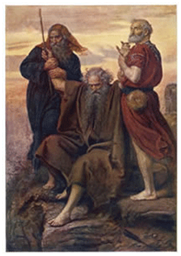Etymology: "Ark”
A biblical tradition considers him an assistant and minister of Moses, a witness to his signs and his substitute (Ex 4, 15.30; 7, 1; 8,1-3). In Ex 17,12: Aaron and Jur hold the arms of Moses praying during the battle to the Amalekites.
Another tradition presents him as brother of the prophet and of Mary, linked to the tribe of Levi and the first of the Hebrew priests, who transmitted that ministry to his descendants (Ex 6, 20.23; 39). His first ministerial or priestly action is described in Ex 16, when God instructs him to take manna and retain it in the tabernacle.
The liturgy of the Church sees in the priesthood of Aaron and in the service of the Levites, as well as in the institution of the seventy "elders" (cf Nm 11, 24-25), prefigures of the ordained ministry of the New Covenant. (CCC 1541)
In the ordination of priests, the Church prays: "God, almighty and eternal [...] already in the first Covenant increased the offices, instituted as sacred signs. When you put Moses and Aaron at the head of your people, to govern and sanctify them, you chose them as collaborators, subordinates in order and dignity, to accompany and support them. So in the desert you multiplied the spirit of Moses, communicating it to the seventy wise men with whom he easily ruled your people [...] Thus you also made the sons of Aaron share in the abundant plenitude granted to their father ... » (Roman Missal: Ordination of Bishops, Priests and Deacons, Ordination of Priests, Prayer of Ordination, 159).
Sadly, he was the builder of the "golden calf" that he requested in the absence of Moses, the first apostasy of the people (Ex 32). He died if he knew the Promised Land (Numbers 20, 1-13). The letter to the Hebrews contrasts his sacrificial priesthood with the former and superior Melchizedek, to whom Christ belongs (Heb 5: 1-4). While Aaron’s priesthood was important to the old covenant, it is fulfilled and perfected by Christ’s priesthood in the new covenant.
